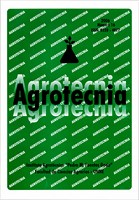Efect of carob sawdust application on soil properties in Chaco province
DOI:
https://doi.org/10.30972/agr.347267Keywords:
manure, sawdust, urea, microbial respirationAbstract
Soils with monoculture systems and intense tillage present a great loss of organic matter (OM). In this research work, the semi-incorporation of carob sawdust with different doses of nitrogenous materials was evaluated to improve soil properties. The treatments were carried out with sawdust (A), urea (U), and manure (E) based on the expected C/N ratios. T1: control; T2: A (30 Mg.ha-1) + U (150 kg.ha-1); T3: A (30 Mg.ha-1) + U (438 kg.ha-1); T4: A (30 Mg.ha-1) + E (11.5 Mg.ha-1); T5: A (30 Mg.ha-1) + E (24.5 Mg.ha-1). After 3, 6, 9, and 12 months of semi-incorporation, the soil was sampled at 0-15 cm depth. Differences between the samplings in the chemical analyses with respect to the control were observed. The values of organic carbon and total nitrogen increased considerably. A tendency towards pH neutrality was observed in the first two samplings, favoring microbiological processes. Microbial respiration was higher in the treated plots compared to the control, mainly in the two treatments with cow manure. Soil bulk density decreased in T5 plots. It is considered that manure is the best option to be used with sawdust in mixtures. Since manure is a waste from livestock activity, it could enter into a low-cost agricultural-livestock scheme. In addition, it provides a greater amount of nutrients as opposed to urea which only provides N. On the other hand, the use of manure with a low N:P ratio could cause the accumulation of large amounts of P.
Downloads
Published
How to Cite
Issue
Section
License

This work is licensed under a Creative Commons Attribution-NonCommercial-ShareAlike 4.0 International License.



